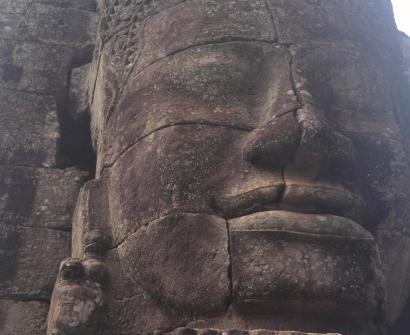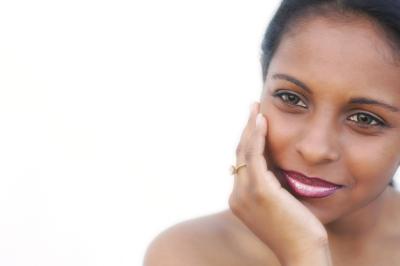Here in my place, I can see from afar Mount Makiling, the famed mystical mountain of Laguna province, about two hours south of Manila. Since my childhood, I have seen the mountain nestled in the east, giving birth to the rising sun everyday. Locals here know that the mountain is the home to a diwata, or a goddess, known as Maria Makiling. It was said that the mountain itself is the shape of her face. I have tried to figure it out, but for years it eluded me. Until my birthday last year, when finally I saw her face – the beautiful silhouette of her forehead, nose, lips and chin along the peaks of the mountain. It was a magnificent sight, a memory that prompted me to find the divine in the face.

(c) Rem Tanauan
Then I remember the huge serene faces carved on massive stones in the towers and structures of Bayon Temple. It was a small temple within the complex of the majestic Angkor Wat. These faces are believed to be the face of Jayavarman VII, the Buddhist Khmer King known for his compassion and wisdom. Long before Mona Lisa, the faces of Bayon bear this ancient enigmatic smile, an unperturbed tranquility that is comparable to the Buddha. Bayon has displayed for centuries a reminder that the human face was once revered as a divine feature.
In some faiths, the face is a sacred symbol. Christian iconography has produced some of the great artworks in painting and sculpture, bearing the haloed images of saints, Virgin Mary and Jesus Christ. Buddhist artisans have carefully crafted the serene face of the Buddha based on the scriptural accounts long after he passed away. Many native traditions across the African continent have used ritual and ceremonial masks copied from the images of animal and of their ancestors, to bear some spiritual purpose and meaning. There is something sacred in the face that is worthy of our sacred attention.
In every human face, the beauty of Love completely reveals itself.
Yet we have lost that truth. Nowadays, we routinely clean, fix and repair our faces, even to surgically alter it to make it acceptable to others, for our measure of worthiness lies on the value of appearance. We use the face as the basis of ugly judgments for judging the ugly, rather than of beautifully witnessing beauty. We have forgotten that there is something in the face that we must face. This reminds me of American psychologist Paul Ekman, who studied microfacial expressions – the small, unnoticeable muscle twitches in the contour of human face reveal deeper, unspeakable emotions. Beneath the rosy cheeks and bushy eyebrows is every person’s inner emotional landscape, an uncharted region worthy of spiritual journey.
In the Judeo-Christian thought, we are told that we are made in the image and likeness of God. Is God, whom we have not seen, exactly appear the same way humans do? Does God have the same physical face? Or there is more beyond? As I reflected over this insight, the Zen koan on the original face came to my mind: What did your face look like before your parents were born? That is quite mind-boggling, to teach us to see the face beyond the physical description of our minds.

(c) Microsoft Image
I feel there is more than just what we can see in the face. Some years ago, I was seated in front of many people inside a school building, as they stream towards me to ask for assistance to register for future classes. In that moment, I saw each face lit up, glowing with soft light. Each face was different, but it is not just being physically pretty or handsome. Each face revealed this deep, mystical beauty that I cannot explain in words. In the spiritually exotic words of modern Irish mystic John O’Donohue, he ">">">writes: “Ultimately it is the soul that makes the face beautiful…As the soul can render the face luminous so too can Love turn up the hidden light within a person’s life.” Years before I started writing and teaching Love, I am grateful of seeing its truth in that one ecstatic moment of flow. In every human face, the beauty of Love completely reveals itself.
Islamic teaching tells us that God has no face, no image, no body and no labels, except God’s wonderful and powerful names. With this in mind, I open up to the insight that the face of the divine is beyond the ideas and forms we ascribe onto it. The true face is no face. It has no eyes but it can see. It has no ears but it can hear. It has not lips but it can speak. It has no nose but it can breathe. Our face must be a representation of that divine truth and intelligence: that beyond the physical face is the face of Love, this empty but essential space, the formless energy that is present and sentient in all.


COMMENTS ( 1 )
posted on 24 April at 03:32
Im thinking also what is the real face of mariang makiling?